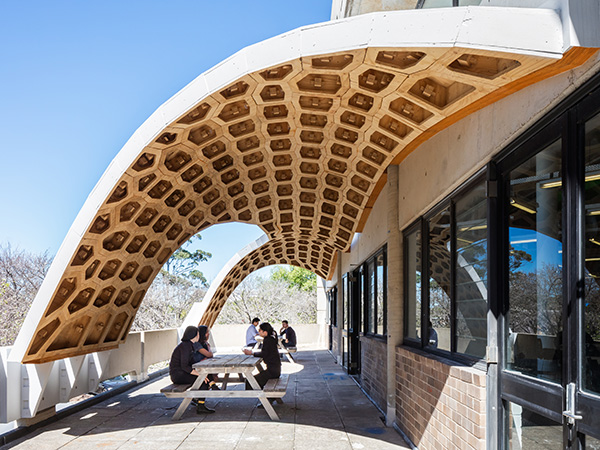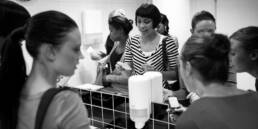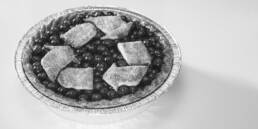Stunning geometric Ecoply shelter
This Content Marketing article was produced for Carter Holt Harvey Plywood and first appeared on Selector.com
“The HexBox is probably the most fun I have had on a project for a while,” explained Eduardo De Oliveira Barata from the Sydney School of Architecture, Design and Planning.
The stunning, geometric form of the HexBox canopy is, “Based on a funicular shell geometry which essentially achieves an equilibrium state of form through corresponding loads constrained by a given boundary.”
Before coming to Australia, De Oliviera Barata worked for a network of architects called Urban Future Organization (UFO) where they were actively pursuing the use of new computation and fabrication tools within architecture. “Through my teaching and practice I aim to embed novel computer-aided fabrication techniques and material technologies to enrich design outcomes.”

Typically, within the Code to Production elective that frames the Hexbox project, students would use software in small teams and propose a project to fabricate using the workshop’s seven axis robots. This elective is completed in a week so the outcomes are usually quite limited. Last year however, the structure was designed beforehand so the students could participate in actually building the temporary structure on one of the terraces of the brutalist-style, Wilkinson Building. This allowed them to gain knowledge of the design software and fabrication tools at a 1:1 scale.
De Oliviera Barata and Christopher Robeller from TU Kaiserslautern in Germany proposed a collaborative project between the two universities. Robeller’s students joined with the USYD students for the assembly and construction phase.
The timber shell is made exclusively of Ecoply® components without the addition of any kind of metal fasteners for the main load-bearing structure. All the hollow polygonal segments that form the boxes are mitred and glued. Once all of the boxes were assembled it was extremely quick to construct without formwork or prior expert knowledge. For its size, the 45 square metre structure is exceptionally lightweight and can easily be disassembled when required.
The trickiest part was the fabrication, dealing with millimetre precision, as the knock-on effect of any inaccuracy would have been disastrous. The build process was very straightforward with 1,531 timber segments cut from 103 sheets of Ecoply, making up 201 boxes. The HexBox project used novel wedge connectors, inspired by traditional wedge joints for a rapid and precise on-site assembly. The structure went up in a week and finished exactly on the last day of the schedule.
Given the University need to have sustainability at the forefront of any project they do, the team were also mindful of the materials used and of reducing waste wherever possible. Ecoply is made from locally harvested, Australian timber and is incredibly efficient in its use of the resource. And FSC® certification guarantees that the timber is also sourced from sustainably managed forests.
The HexBox canopy provides a space which students can use for the entire day providing shading from the sun and protection from the rain, as well as respite from their computers and a dose of design inspiration.
Related Posts
September 25, 2020
Tork helps Macquarie University build their reputation
B2B Content Marketing article for Tork…
November 20, 2019
Accurate continence assessments, improving outcomes for residents
B2B Content Marketing article for TENA…




